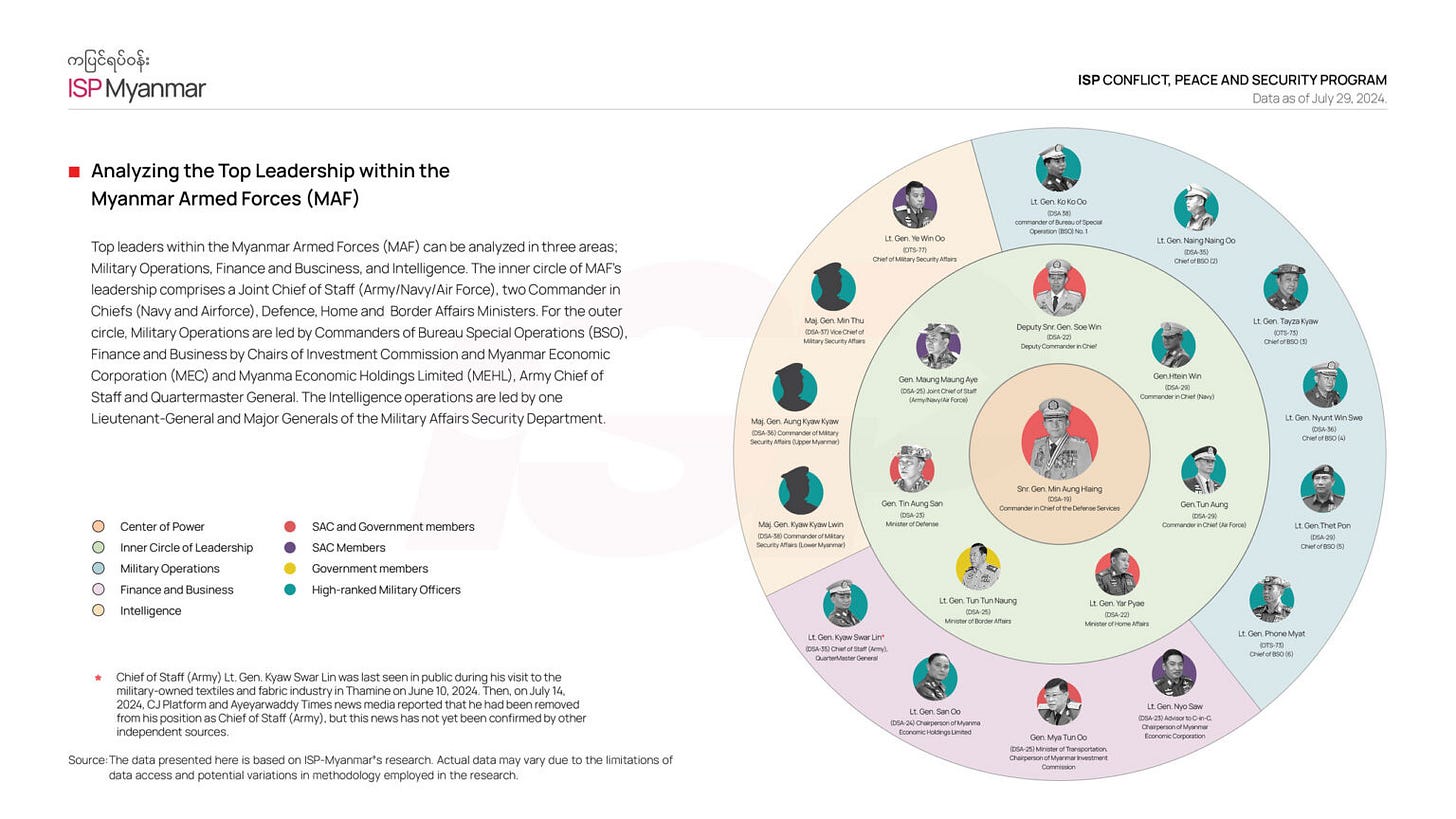Nay Pyi Taw’s Chaos: Unraveling the Rumors of a Countercoup
The power structure within Myanmar’s military is tightly controlled by Min Aung Hlaing and his inner circle, making any attempt to overthrow him highly unlikely.
On the morning of August 13, 2024, Myanmar was abuzz with rumours of a countercoup, causing a ripple of uncertainty across the nation and the international community. The prospect of a shift in power within the military junta, known as Sit Tat, ignited widespread speculation. However, a closer examination of these rumours and the power dynamics at play within the military leadership reveals that these hopes are unfounded.
The spark for the countercoup rumours came from a report by the Ayeyarwaddy Times on August 13, 2024, claiming an unsuccessful attempt at a countercoup led by an unnamed General. According to the report, the military had heightened security around the “Row of Six Mansions” in Nay Pyi Taw, a neighbourhood where top former military leaders reside. This was quickly followed by a Facebook live post from ex-captain Nay Myo Zin, a resistance movement figure, who alleged that the wife of Vice Senior General Soe Win, Deputy Commander-in-Chief of the Armed Forces, had fled to the United Arab Emirates (UAE), and that Senior General Min Aung Hlaing was seeking political asylum in China. The Chindwin News Agency, known for its unverified reports, amplified these claims, although it later retracted some details. Another Facebook page associated with ex-captain Zin Yaw, who joined the Civil Disobedience Movement after the coup, also chimed in, claiming that Lieutenant General Aung Lin Dwe, Secretary of the State Administration Council (SAC), had led the countercoup.
Yet, despite the flurry of rumours, there is little evidence to support these claims. No independent media outlet has confirmed the news about Soe Win's wife, even 24 hours after the initial reports. Additionally, there are inconsistencies in the narrative. The Ayeyarwaddy Times mentioned a General as the countercoup leader, but Aung Lin Dwe, the figure mentioned in other reports, holds the rank of Lieutenant General. Moreover, Aung Lin Dwe was removed from his military position as Judge Advocate General in January 2022 and placed in the reserve force, limiting his influence. Throughout his military career, he served as the Commandant of the Defence Services Institute of Technology (DSIT), Western Regional Military Command Commander, Director of Military Records, and then Judge Advocate General. He only administered combat forces while he was Commander of the Regional Military Command. Compared to other Generals and Lieutenant Generals, such as the Chiefs of the Bureau of Special Operations, who commanded combat forces throughout their career development, Aung Lin Dwe had limited opportunities to build personal loyal combat forces under his command. Therefore, it is impossible for Aung Lin Dwe to conduct a countercoup against Min Aung Hlaing.

Moreover, the prospect of a countercoup led by a General is also very slim. There are six Generals in the military currently: Joint Chief of Staff (Army, Navy, Air Force) General Maung Maung Aye (DSA-25), Commander-in-Chief (Navy) General Htein Win (DSA-29), Commander-in-Chief (Air Forces) General Tun Aung, Defense Minister General Tin Aung San (former Commander-in-Chief, Navy, DSA-23), Communication and Transportation Minister General Mya Tun Oo (former Joint Chief of Staff), and SAC Office Minister (1) General Moe Aung (DSA-28). The current Joint Chief of Staff was placed into the reserve force before being appointed to the No. 3 position in the military by Senior General Min Aung Hlaing. Min Aung Hlaing also favours General Tin Aung San as Defense Minister. Therefore, their military positions are indebted to Min Aung Hlaing. There is no precedent or possibility that the Commanders-in-Chief of the Navy and Air Forces would challenge the strength of the Armed Forces and conduct a countercoup against the Senior General and Vice Senior General of the Armed Forces. Moreover, these Generals have close patron-client relationships with the two military leaders.
Although General Moe Aung was removed from his position as Commander-in-Chief of the Navy, he was appointed SAC Office Minister (1) and National Security Advisor in January 2024. Even if he was unhappy with the removal of his military position, he had limitations in countering the strength of the Army as a General who commanded the Navy. This leaves General Mya Tun Oo as the prime suspect for a countercoup, as he was once popular as the predecessor of Min Aung Hlaing but was stripped of all important positions after the coup. General Mya Tun Oo served in different command positions in the army and had the rare opportunity to command combat forces and intelligence units. Therefore, he had the chance to build a loyal network within the military and personal power. However, he would face great risk if he attempted a countercoup against Min Aung Hlaing, who is surrounded by Chief of Military Affairs Security Lieutenant General Ye Win Oo, Min Aung Hlaing’s right-hand man, and his father-in-law, General Maung Maung Aye, the 3rd in Command of the military, who now commands both combat and intelligence forces. Therefore, it would be reckless to attempt such a risky act while Generals and Lieutenant Generals are continuously being removed from top positions. Hence, the likelihood of General Mya Tun Oo initiating a countercoup is very slim.
In conclusion, while the rumours of a countercoup have captured public attention, the actual prospects of such an event are slim. The power structure within Myanmar’s military is tightly controlled by Min Aung Hlaing and his inner circle, making any attempt to overthrow him highly unlikely. As the dust settles, it becomes clear that these rumours are more a reflection of wishful thinking or disinformation than an impending reality.



